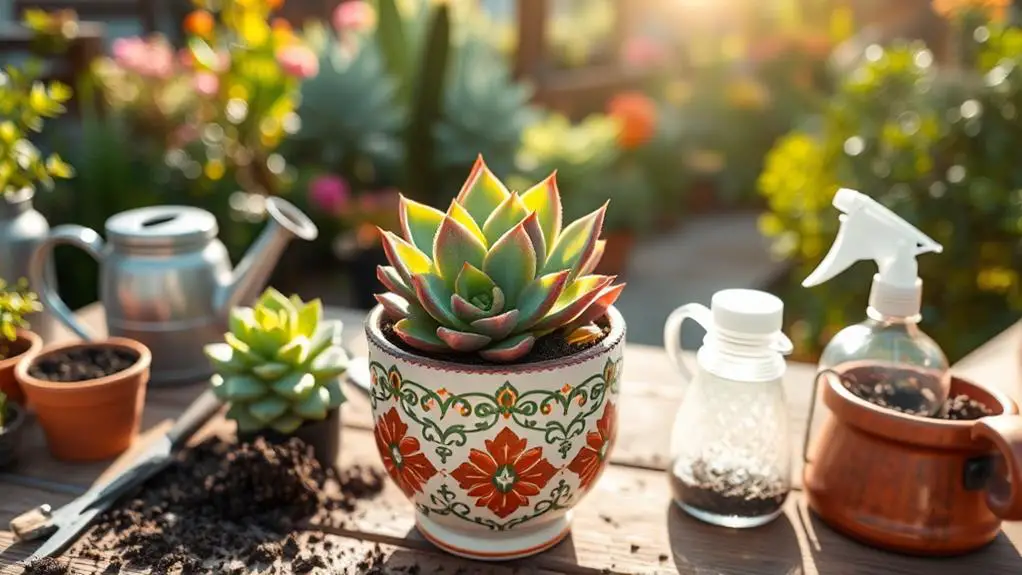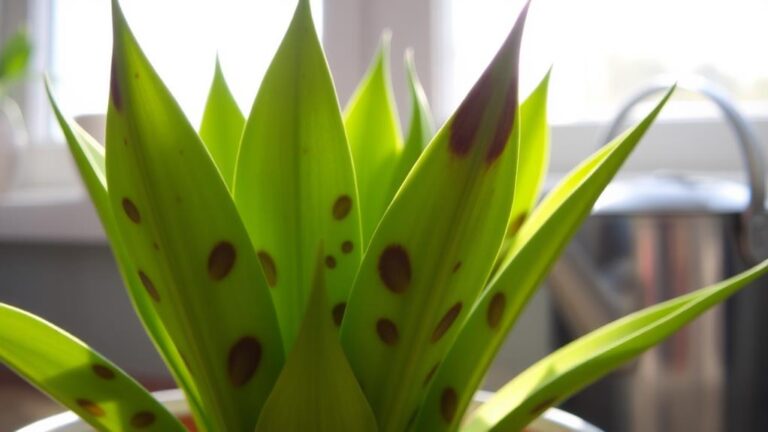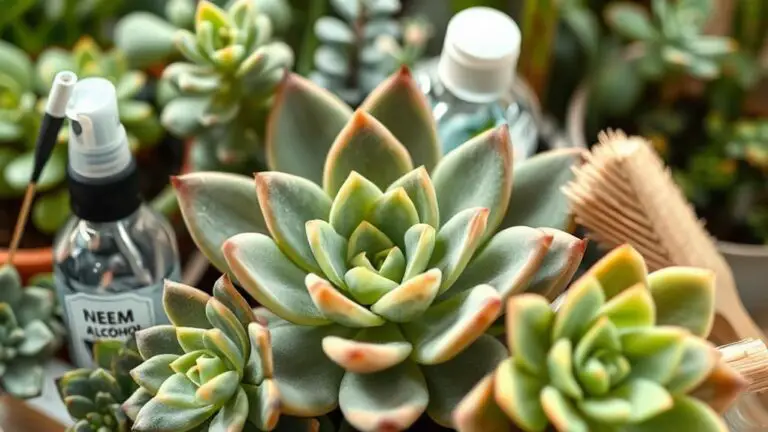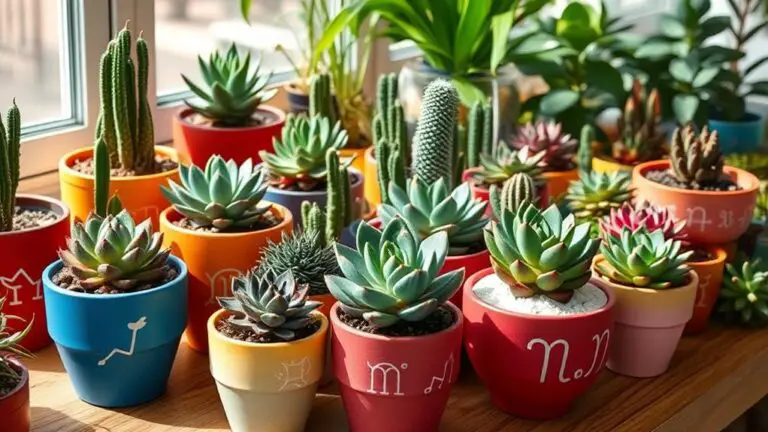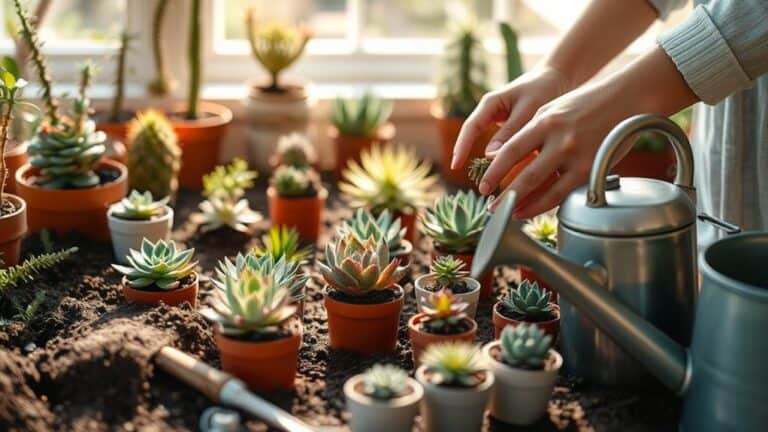Echeveria Care Guide 101 – 5 Essential Steps
If you've recently added an Echeveria to your plant collection, you're probably keen to keep it thriving. It all begins with understanding the basics of Echeveria care, starting with the right soil and lighting conditions. You might be surprised at how important it is to let the soil dry out completely between waterings. But that's just the tip of the iceberg. Want to uncover the secret to lush, vibrant foliage and tackle potential pest problems with ease? Stick around as we break down these five essential steps for maintaining your Echeveria's health.
Understanding Echeveria Basics
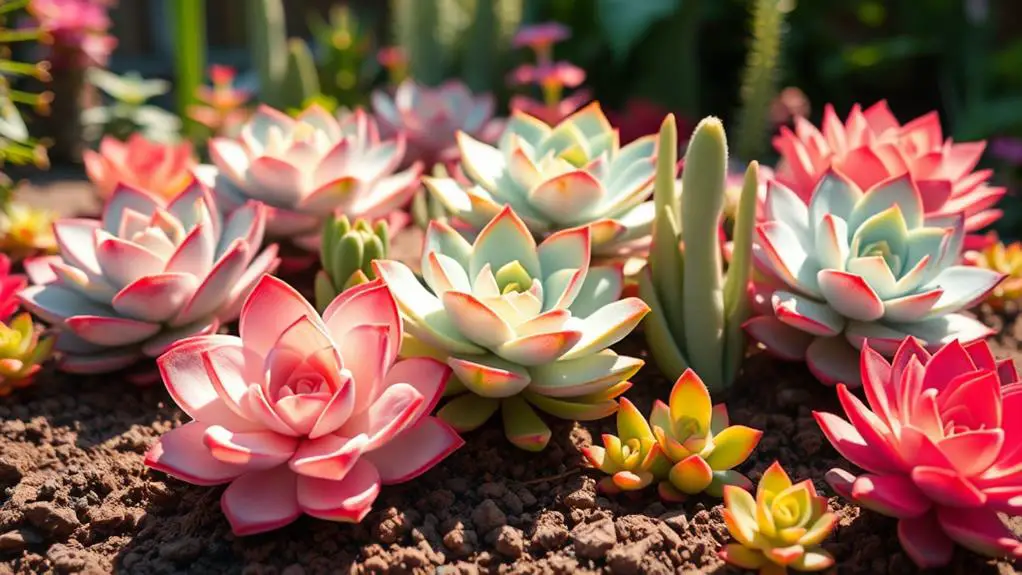
Echeveria's charm lies in its rosette-shaped leaves and vibrant variety, with over 150 species within the Crassulaceae family. These succulents are native to semi-desert regions of Central America and Mexico, making them well-suited to home gardening. Understanding basic Echeveria care is vital for their health and beauty.
First, confirm your Echeveria is planted in well-draining soil. This prevents water from sitting around the roots, which can cause rot. They thrive in bright indirect sunlight, so place them where they'll get plenty of light without direct exposure.
Echeverias are drought-tolerant, storing water in their fleshy leaves. You should follow a minimal watering routine, allowing the soil to dry completely between sessions.
Ideal temperatures for Echeveria range from 65°F to 80°F (18°C to 27°C). They're frost-sensitive, so if you live in a colder climate, you'll need to protect them from freezing temperatures.
During the growing season, you can propagate Echeveria easily from leaves or offsets. This makes it fun and easy to expand your succulent collection.
Optimal Lighting Conditions
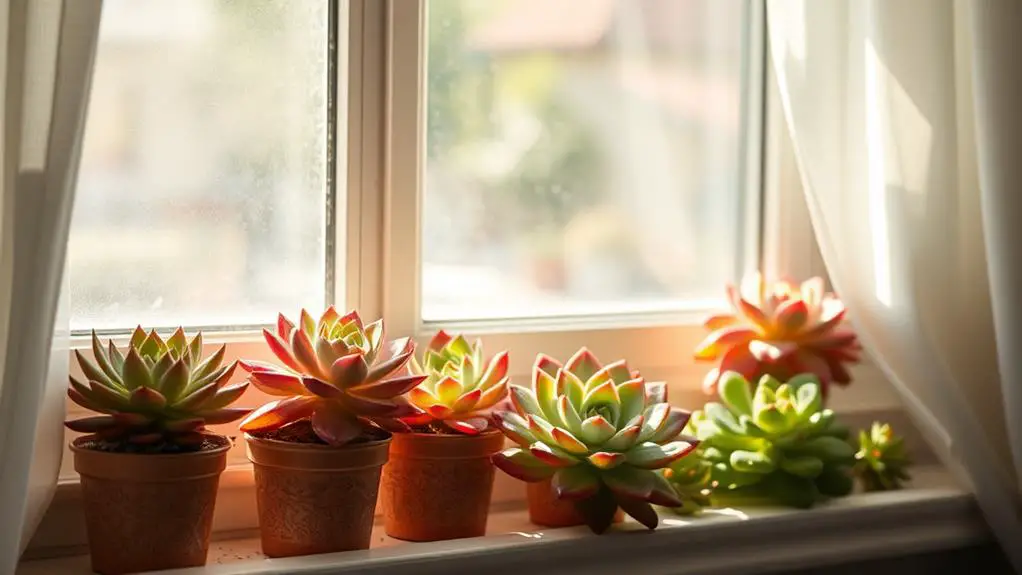
After understanding the basic care requirements for Echeveria, let's focus on the perfect lighting conditions that will keep your plant healthy and vibrant. Echeverias thrive with at least 6 hours of bright, indirect sunlight daily. Position your plant near south-facing or west-facing windows to guarantee it gets ample light while avoiding the harsh midday sun, which can cause sunburn. Morning or late afternoon sun is perfect because it provides warmth without the intensity.
Here's a quick guide to ideal lighting conditions:
| Light Condition | Result |
|---|---|
| Bright, indirect light | Healthy, vibrant growth |
| South-facing window | Perfect for maximum light |
| West-facing window | Good light, avoid midday sun |
| Grow lights | Useful when natural light is limited |
Insufficient light can lead to etiolation, causing your Echeveria to stretch toward the light source. This results in leggy growth and a less healthy plant. If you notice your plant becoming leggy, consider adding supplemental grow lights. These can mimic the sunlight your Echeveria needs. Remember, the goal is to provide a balanced light environment to keep your plant looking its best. Don't worry, with a bit of attention, your Echeveria will flourish!
Proper Watering Techniques
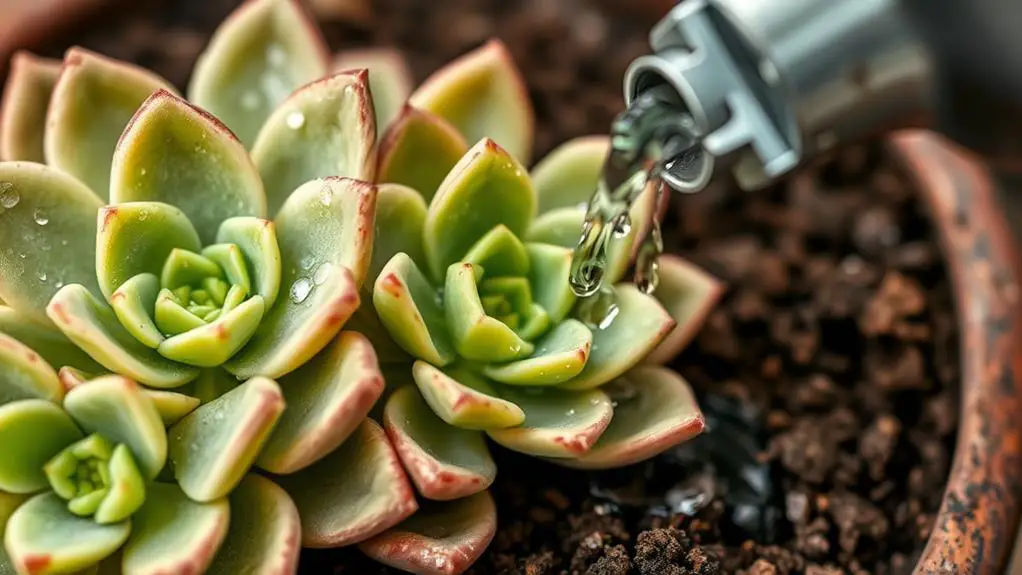
Proper watering techniques are essential for maintaining a healthy Echeveria. First, remember to water your Echeveria only when the soil is completely dry to the touch. This usually means every 1-2 weeks during the growing season and less often in fall and winter. Doing so prevents root rot, a common issue for overwatered succulents.
To guarantee proper drainage and moisture distribution, use the "soak and dry" method. Thoroughly water the plant until excess water drains out from the bottom. Then, let the soil dry out entirely before the next watering session. This technique helps prevent rot and keeps your Echeveria healthy.
Always use room temperature water to avoid shocking the plant. Before watering, check the top 1.25 inches of soil for dryness. If it feels dry at this depth, it's time to water.
Remember to water around the base of the plant and not on the leaves. This helps prevent mold and fungal infections.
Ideal Soil and Potting
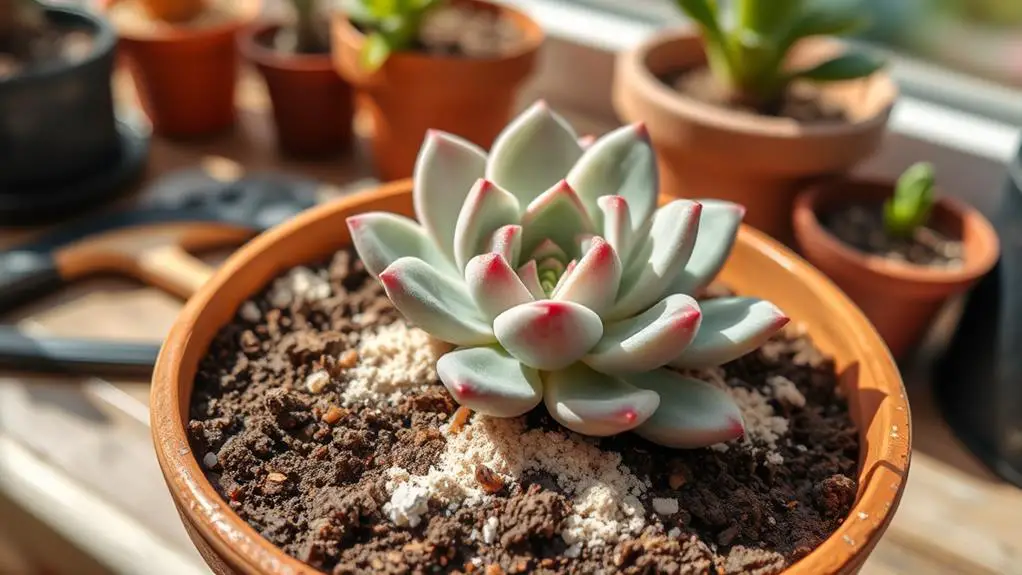
Ensuring proper watering is just one part of keeping your Echeveria healthy; choosing the right soil and potting method is equally important. Echeverias need well-draining soil to prevent root rot and promote healthy growth. A cactus or succulent mix is perfect because it lets excess water escape easily.
When potting your Echeveria, pick a container that's 5-10% larger than the plant's diameter. Make sure it has drainage holes. These holes are essential for excess water to drain out, keeping the roots dry and happy.
Terracotta pots are highly recommended. They provide excellent drainage and allow moisture to evaporate, reducing the risk of overwatering. Avoid using regular garden soil, as it holds onto moisture and can harbor pathogens that might harm your Echeveria. Instead, stick to a good succulent mix.
It's also a good idea to repot your Echeveria every 2-3 years, ideally before the growing season. This gives you a chance to refresh the soil and check the roots. Trim any damaged roots to keep your plant healthy.
Fertilization Tips
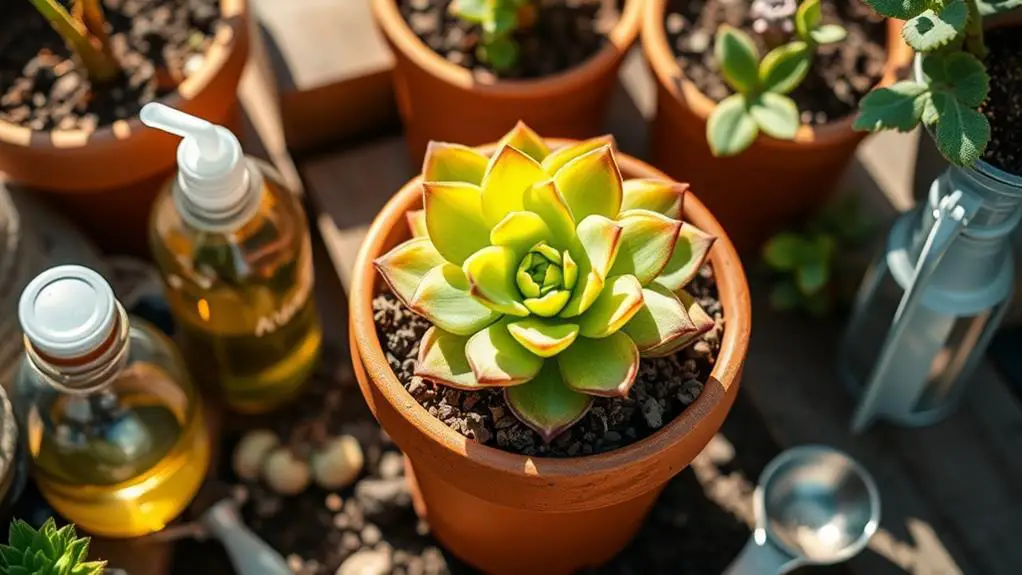
When it comes to fertilizing your Echeveria, timing and choice of fertilizer are key.
During the growing season in spring and summer, use a diluted succulent fertilizer once a month to boost healthy growth.
Opt for a balanced or cactus-specific fertilizer, but remember to halve the dosage to avoid over-fertilizing.
Optimal Fertilization Schedule
To keep your Echeveria thriving, fertilize it during its active growing season in spring and summer. An ideal fertilization schedule involves using a diluted succulent fertilizer once a month. Make certain to halve the recommended dosage to prevent over-fertilization, which can harm your plant.
During the summer and spring, your Echeveria needs more nutrients to support healthy growth. Here are some key tips to follow:
- Use a balanced fertilizer: This guarantees your Echeveria gets a mix of essential nutrients.
- Monitor your plant's response: Adjust the frequency and concentration if you notice any changes.
- Avoid fertilizing in fall and winter: Echeveria enters dormancy and needs fewer nutrients during these seasons.
Organic fertilizers are often recommended for Echeveria because they promote better nutrient absorption and maintain a healthy growing environment.
However, always monitor your plant's response to any new fertilizer. If your Echeveria looks stressed or shows signs of over-fertilization, such as yellowing leaves or stunted growth, reduce the amount or frequency.
Choosing Organic Fertilizers**
While fertilizing your Echeveria during the growing season is important, choosing the right type of fertilizer can greatly impact its health. Organic fertilizers are your best bet because they provide essential nutrients without the risk of chemical buildup in the soil. This promotes healthy growth and development. You should apply diluted organic fertilizers once a month during the spring and summer for ideal nutrient absorption.
Using compost tea or fish emulsion can offer a balanced nutrient profile that's perfect for succulents like Echeveria. However, be cautious with the amount you use to prevent over-fertilization. It's best to apply half the recommended dosage for regular plants, as too many nutrients can harm your Echeveria.
Organic fertilizers also benefit the soil structure and enhance microbial activity, which further supports the overall health of your plant.
Here's a quick comparison of organic fertilizers:
| Fertilizer Type | Benefits | Application Frequency |
|---|---|---|
| Compost Tea | Balanced nutrients, improves soil structure | Once a month (diluted) |
| Fish Emulsion | Essential nutrients, boosts microbial activity | Once a month (diluted) |
| Worm Castings | Enhances soil health, rich in essential nutrients | Once a month (lightly mixed) |
Choose organic fertilizers for a healthier, more vibrant Echeveria!
Managing Pests and Problems
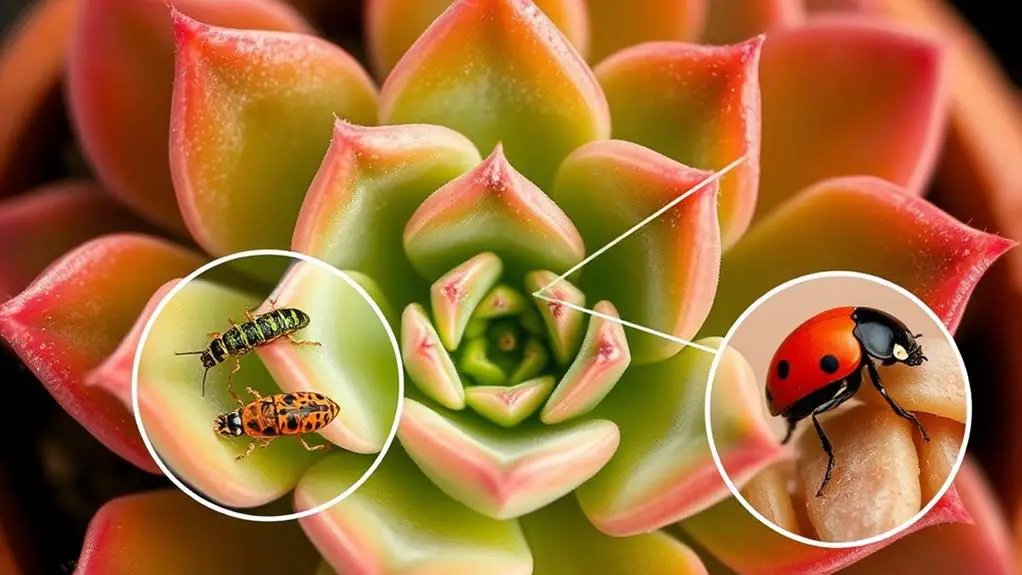
Caring for Echeveria plants involves staying one step ahead of potential pests and problems. Regularly inspect your plants for common pests like mealybugs, aphids, and spider mites. These pests can cause discoloration and wilting if left untreated.
To manage pest infestations, apply insecticidal soap or neem oil promptly, ensuring thorough coverage of affected areas for effective control.
Be vigilant about overwatering, as it can lead to root rot and fungal diseases. Always allow the soil to dry completely between watering sessions.
Prevent mold growth and fungal infections by ensuring good air circulation around your plants and avoiding overcrowding in pots or garden beds.
Here are a few tips to keep your Echeveria healthy:
- Manage pests: Regularly check for mealybugs, aphids, and spider mites. Use insecticidal soap or neem oil if you spot any.
- Prevent root rot: Avoid overwatering and let the soil dry out between waterings.
- Ensure good air circulation: Prevent fungal diseases by spacing your plants properly.
Lastly, watch out for sunburn from prolonged exposure to harsh direct sunlight. Look for brown or white patches on leaves and provide filtered light if necessary.
Following these steps will help keep your Echeveria thriving!
Frequently Asked Questions
How Do I Take Care of My Echeveria?
Place your Echeveria in bright, indirect sunlight for at least 6 hours daily. Water thoroughly, letting soil dry between waterings. Use well-draining soil, fertilize monthly in spring/summer, and check for pests regularly.
How Often Should Echeveria Be Watered?
You should water your Echeveria every 1-2 weeks during spring and summer, letting the soil dry out completely between waterings. In fall and winter, reduce watering considerably since the plant enters a dormant phase and needs less moisture.
Should I Cut the Flowers off My Echeveria?
Yes, you should cut the flowers off your Echeveria if you want to prioritize leaf growth. Trimming the flower stems at the base with clean scissors helps the plant conserve energy, making it healthier and more vibrant.
Does Echeveria Need Sun or Shade?
Echeveria needs at least 6 hours of bright, indirect sunlight daily. Place it near south or west-facing windows, but protect it from harsh midday sun. If natural light is limited, consider using grow lights to supplement.
Conclusion
With these five essential steps, you're well on your way to mastering Echeveria care. Remember to provide well-draining soil, plenty of indirect sunlight, and let the soil dry out before watering again. Don't forget to use diluted fertilizer during the growing season and keep an eye out for pests. By following these simple tips, you'll keep your Echeveria healthy and vibrant. Happy gardening, and enjoy your beautiful succulents!

